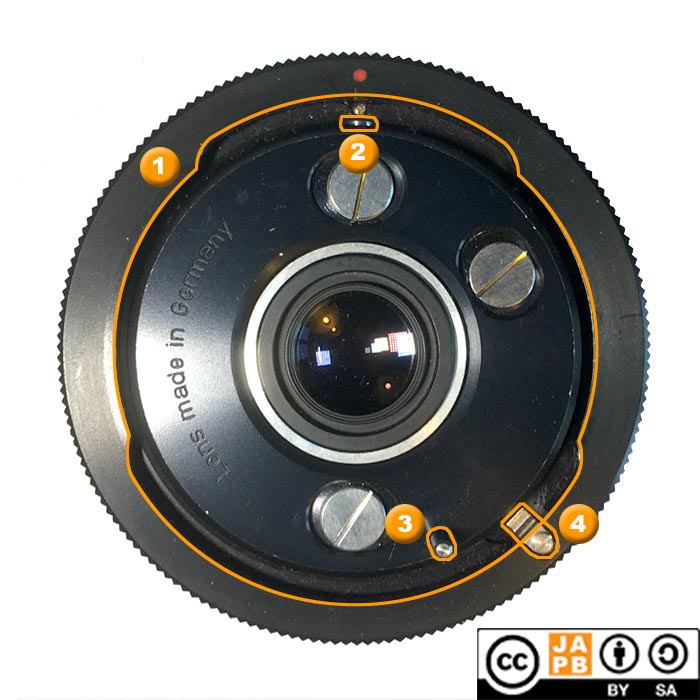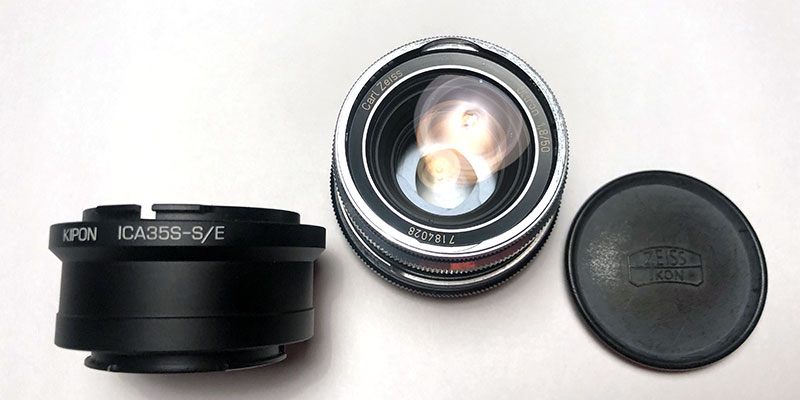Pekka Buttler (Updated 5/2025)
Icarex BM mount specifications
Mount type: breech-lock (ring on lens)
Flange focal distance: 48 mm
Film format: 36mm x 24mm (‘Full frame’)
Mount communication: Aperture stop-down pin (body-to-lens communication)
Identifying the Icarex mount?

Key characteristics of the mount of Icarex BM lenses:
[1] Breech-lock ring with two openings of different sizes
[2] Breech-lock registration pin (always aligned with lens top)
[3] Aperture stop-down pin
[4] Thingamajig (I have no idea what this is for. If someone knows, please enligten me)
Note! The rear of Icarex BM lenses typically (based on four lenses) have very prominent slot-screw heads, but their number and spacing is not a definite characteristic.
Information on the Icarex BM mount:
The Icarex BM (for “bayonet” mount) was introduced in tandem with the Zeiss Ikon Icarex 35 camera in 1966. The story of the Icarex camera and “bayonet” is a sordid tale of how – in some rare cases – companies have a technologically competent product, but still manage to do everything wrong. In short:
• Zeiss Ikon was worried about the Icarex eating into sales of their other products (Contarex and Contaflex). Hence, the Icarex was crippled and repeatedly delayed until it was obsolete at launch.
• Only three lenses were offered for the Icarex at launch, and two of those were different 50/2.8’s (a four element ‘Tessar’ and a three element ‘Pantar’) and it took another two years before Zeiss Ikon launched anything wider than 50 mm and anything narrower than 90 mm (even though the designs were available).
• The Icarex was initially launched without any built-in metering, even though the major competition offered integrated metering (and was able to sell well due to this). Integrated metering capability was added to the Icarex only in 1969.
• After launching the Icarex, Zeiss Ikon had one more mount to support. This was partially due to that …
• The Icarex was not originally a Zeiss Ikon design. Instead it was a design Zeiss Ikon inherited from Voigtländer (Zeiss Ikon had acquired Voigtländer earlier). The not-invented-here element probably contributed to Zeiss Ikon’s lacklustre effort in pushing the Icarex.
• Almost of all lenses manufactured in Icarex BM mount (under the ‘Carl Zeiss’ brand were rebadged Voigtländer lenses1. Even the BM mount 50/2.8 “Tessar” was actually a Voigtländer Skopar. As such this is not a bad thing (Voigtländer was an optics pioneer), but shows how the Icarex was to be the unwanted stepchild.
• As sales were disappointing, Zeiss Ikon launched a parallel series of Icarex cameras with m42 thread mount in 1969. Subsequently, Icarex cameras would be either “TM” (m42) or “BM” (Icarex). (Any Icarex cameras without a “TM” badge are “bayonet” mounted)
• To add insult to injury, the Icarex “bayonet” mount is actually a breech-lock mount (which is why I’ve parenthesized “bayonet”).
And if you think this sounds too unbelievable to be real and you’re convinced I’m tripping, at least I’m not tripping alone.
As such, this sorry story is indicative of the miserable end-game of the (west) German camera industry. While many like to portray this tale simply as a “could not compete against cheaper asian labour” -story, it is actually a story of arrogance, incompetence, infighting, and chronic indecision. Maybe I’ll tell my take (the management scholar’s version) one day. In any case, all this resulted in that the Icarex BM mount was officially discontinued in 1971, after only 5 years.
Adapting Icarex BM lenses:
Thanks to the relatively forgiving flange focal distance (48 mm) of Icarex BM lenses, there are few theoretical or practical impediments to adapting these lenses – both to dSLR’s and mirrorless cameras. On the other hand, due to the relatively meagre installed base of these lenses, third party adapter manufacturers have not been too eager. Resultingly, while adapters exist, only some mounts are covered. Furthermore, dedicated Icarex BM speed boosters (for owners of APS-C bodies) do not exist. Hence, should one want to speed boost an Icarex BM lens, one needs to find a suitable combination of adapter ring and speed booster.
Once an adapter has been acquired, the use of Icarex BM lenses on MILC is very straightforward. Furthermore, the 10 Icarex BM lenses manufactured by Zeiss/Voigtländer are of the highest build quality, and while usability-wise some of them may be considered somewhat quirky (even medium tele lenses like the 200/4 Dynarex have a very narrow focus ring), their build quality is second to none. Furthermore, Zeiss/Voigtländer Icarex BM lenses are devoid of click-stops (which especially some will appreciate).
But, you might ask, why give a flying fig about a lens mount that only ever offered ≈10 in-house* lenses, many of which were later also made available in M42?
Three reasons, and only the last one really matters:
– First, and I acknowledge that this might be very personal, but for me dabbling with legacy lenses goes hand in hand with a morbid interest in the history of photographic machinery, and due to this, I admit to having a fascination towards the death-throes of a company that was once the trailblazer of the industry.
– Second, the fact that M42 is one of the most popular lens mounts of all time, does not make it a good system (in the technical sense). Personally, if I was offered the same lens in M42 and Icarex mounts 2 and handed a pro-level adapter for both, I would gladly go with Icarex any day.
– Thirdly, While none of the ‘Carl Zeiss’ -branded lenses for the Icarex system is a real dog, there are a number (two, if you’re being critical; one, if you’re in a really foul mood) of lenses offered for the Icarex system that shine: The 35/3.4 Skoparex and the fabled 50/1.8 Carl Zeiss Ultron 3. And while the Ultron was also available in M42, (last time I checked) the price difference between the average Icarex and M42 Zeiss Ultron sales was sufficient to justify the investment in a pro-level Icarex-NEX adapter 10 times over.

Footnotes:
1 For those in the know, the nomenclature of Icarex lenses are a dead giveaway, as they typically combine the name ‘Carl Zeiss’ with classic Voigtländer lens names (e.g. ‘Skoparex’, ‘Ultron’, or ‘Dynarex’).
2 Also other manufacturers (some of the customary third party manufacturers) offered lenses for the Icarex BM mount, but these are relatively rare.
3 In the dying days of the Icarex system, Carl Zeiss also introduced a 25 mm f/4 Distagon (incidentally, the only Icarex lens that was not a Voigtländer design), but as it was introduced only months before the entire system was discontinued, it was made available only in M42 mount and it is extremely rare (only some tens of copies according to one source. I have therefore discounted it from most of the article.